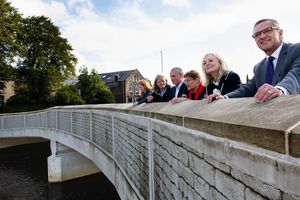Fifth anniversary of the Calderdale Flood Action Plan
The Calderdale Flood Action Plan is five years old this month and to acknowledge this important milestone, the Environment Agency, Calderdale Council and its partners are reflecting on key successes since 2016.

Flood defences at Mytholmroyd which were completed this year
Created following the floods of Boxing Day 2015, the plan aims to reduce the impact of flooding and make the region more resilient to climate change. Actions completed as part of the plan are also part of the Environment Agency’s and partners plans to be prepared for winter.
The plan is a ‘living document’ and enables organisations to plan together effectively to achieve common goals. It is overseen by a group called the Calderdale Flood Programme, which brings together a range of partners including Calderdale Council, the Environment Agency, Yorkshire Water, Network Rail, the Canal and River Trust, local flood groups, the voluntary sector and community groups. Progress to date has been strong, with over 50 per cent of actions completed or nearing completion.
There are four themes of the Plan – Strengthening Defences, Natural Flood Management, Resilient Infrastructure and Community Resilience. The combined actions of these themes work together to slow the flow of flood water and reduce flood risk along the whole of the Calder Valley.
Jo Arnold, who leads on the Calderdale Flood Action Plan for the Environment Agency, said:
It’s fantastic that The Calderdale Flood Action Plan is still an invaluable living document five years after inception. The plan outlines the work the partnership, communities and people have delivered and will continue to deliver to reduce flood risk to homes and businesses in the Calder Valley.
The Flood Action Plan is a great roadmap of how we and many other organisations help better protect communities from flooding, and shows what we are doing to prepare for whatever this winter may bring. However, what is equally as important is that people check their flood risk and sign up to flood warnings. Despite our efforts, we cannot prevent all flooding. It’s vital everyone knows the threat to them and how to keep loved ones, property and possession safe.
Cllr Scott Patient, Calderdale Council’s Cabinet Member for Climate Change and Resilience said:
In the five years since the launch of the Calderdale Flood Action Plan we’ve seen some fantastic progress to help reduce the risk of flooding in the borough. From major schemes to the efforts of our incredible volunteers, the completion of every action has made a difference and helped increase our resilience to flood events.
Unfortunately, our changing climate makes extreme weather events more likely to occur. Alongside specific flood reduction schemes as part of the Flood Action Plan, we’re also leading the way in our fight against climate change – work that requires significant effort and a cultural and behavioural shift.
We’ve come a long way since the launch of the Flood Action Plan, but this work isn’t slowing down. We’ll continue to work together with our partners and volunteers to develop our flood response work, alongside our commitment to the climate agenda, to do all we can to protect our communities from the impacts of flooding.
One key achievement since the creation of the plan has been the completion of the £41m flood defence scheme at Mytholmroyd, which now better protects over 400 homes and businesses.
The scheme included the construction of new, raised and improved flood walls, the relocation of Caldene Bridge, widening of the river channel at key locations and floodproofing of many buildings next to the River Calder and Cragg Brook.
The Environment Agency has also completed a £4 million repair programme of work after Storm Ciara in February 2020. This included the demolition of Shade Chapel, Todmorden, which was badly damaged by the floods, reducing the risk of flooding to 250 properties. Other emergency work included repairing damaged flood defences throughout the valley and stone/shoal clearance removal from river channels.
Under natural flood management (NFM), over 20 partners are working together on an NFM programme which has so far seen 600 leaky dams installed at Hardcastle Crags, 112,245 trees planted at Gorpley Reservoir and over 700 hectares of moorland planted with sphagnum moss to help hold back water and slow its flow, reducing flood risk further down the valley.
Infrastructure is also more resilient now with the relocation of 11 substations and three more to be relocated next year.
Good progress has also been made on community resilience through our teams of volunteer flood wardens and improvements to the Environment Agency’s flood warning service and sirens across the valley. There are 32 flood warnings that cover 7,577 properties. Over 25 of these warnings now have a take up rate of 80 per cent.
The infographics which have been created to show the progress of the Calderdale Flood Action Plan five years on can be found at: https://eyeoncalderdale.com/FAP-5-years-on
The full plan can be found at www.eyeoncalderdale.com/flood-action-plan